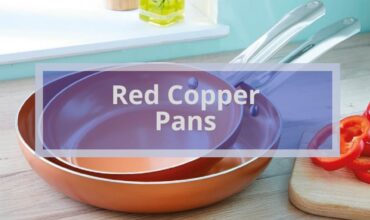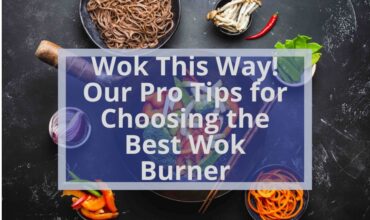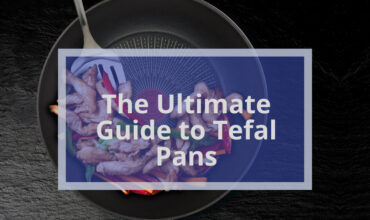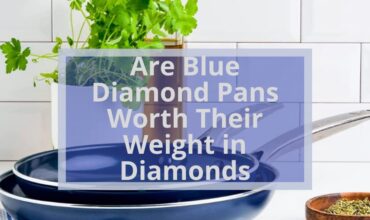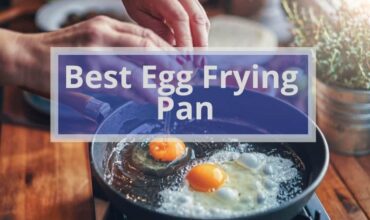In short – it depends. This ceramic-coated copper cookware provides some valuable benefits but has some significant downsides. The combination of copper and ceramic construction promises excellent heating, nonstick versatility, and easy cleanup. However, real-world experiences reveal some potential pitfalls as well.
Get the full scoop on whether Copper Chef delivers on its claims, weigh the pros and cons and how it compares to other leading cookware before you buy. And in case you take the copper plunge, a few essential tips can help maximize the performance.
So, Let’s dig into the details to uncover the absolute truth about Copper Chef!
Overview of Copper Chef Cookware
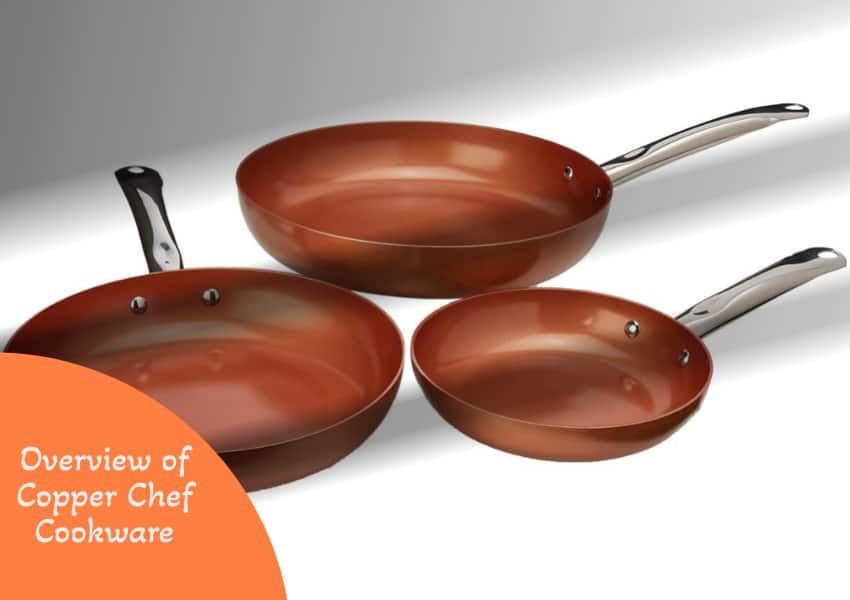
Copper Chef pans have a ceramic nonstick coating on a copper base. It comes in sizes like 6-inch skillet, 9-inch square pan, and 11-inch-deep pan. These interchangeable pans let you fry, bake, roast, steam, and more. The set also includes tempered glass lids.
Copper Chef Manufacturing Process
- Copper Chef pans start with a stainless-steel disk that forms the base. A layer of copper is fused to the disk at extreme heat. This bonds the metals together.
- Next, the cooking surface is coated with CeramiTech nonstick coating. This is added as a liquid and then hardened. Copper Chef says no PTFE or PFOA is used.
- The stainless-steel sides are attached next. These make the pan durable and avoid reactions with foods. Rivets reinforce the side handles.
- Finally, the tempered glass lids are made. These let you see inside while trapping heat and moisture. The finished pans are checked for quality.
Fusing the metals and coating creates a pan that conducts heat quickly. The manufacturing process combines the benefits of copper and nonstick. This allows for versatile cooking and easy cleaning.
1. Benefits of Stainless-Steel Base
The stainless-steel disk that forms the base gives some key benefits:
Durability – Stainless steel is solid and resists dents. It makes the bottom durable for long-term use.
Stability – The flat stainless base keeps the pan stable on the stove. It won’t warp or spin like thinner metals can.
Bonding – The steel base allows the copper layer to fuse on at high heat. This creates a tight bond between the metals.
Food safety – Stainless steel doesn’t react with acidic foods like raw copper can. It maintains food safety.
Appearance – The brushed stainless look is attractive and matches other appliances. It hides scratches better than shiny copper.
The stainless-steel base boosts durability, stability, safety, and appearance. It creates a solid foundation for the copper heating layer on top.
2. Benefits of Copper Layer
The layer of copper fused to the base provides key benefits:
Even heating – Copper spreads heat quickly and evenly. It prevents cold spots while cooking.
Responsiveness – Copper reacts fast when you change the stove heat. It sears and fries food perfectly.
Efficiency – Excellent conductivity means less energy is lost. It uses stove heat very effectively.
Versatility – Copper works well for sautéing, baking, frying and more. It allows varied cooking methods.
Appearance – The copper bottom looks excellent and is considered higher-quality cookware.
Safety – Copper alone can react with acids, but the steel base prevents this.
Overall, the fused copper layer leverages copper’s fantastic ability to conduct heat. This makes cooking faster, more even, and more efficient.
3. Benefits of CeramiTech Coating
The CeramiTech nonstick coating provides several benefits:
Nonstick – Food doesn’t stick to the ceramic surface, making cooking and cleaning much easier.
Oil-free – The nonstick surface lets you use little or no oil for healthier cooking with less fat.
Easy release – Food releases from the pan smoothly, whether frying eggs or baking muffins.
Durable – Copper Chef says the coating is ultra-durable and withstands metal utensils.
Safe – CeramiTech claims to be free of potentially harmful PFOA and PTFE chemicals.
The nonstick ceramic coating offers easy cooking, cleaning, and healthy, oil-free cooking. How long the nonstick lasts depends on usage and care.
4. Benefits of Stainless-Steel Sides and Handles
The stainless-steel sides provide these advantages:
Durability – Stainless steel is solid and resists dents or warping. This makes the pans last a long time.
Appearance – The brushed stainless look matches most kitchens and hides scratches well.
Safety – Stainless steel does not react with acidic foods like raw copper can. It maintains food safety.
Stability – The stainless sides keep their shape and won’t spin on the stove like thinner pans.
Handles – Riveted stainless handles let you securely lift and manoeuvre the pans.
Versatile – Stainless steel withstands oven, grill, and broiler heat for varied cooking.
The stainless-steel sides boost durability, appearance, food safety, and versatility. They complement the copper base for excellent all-around performance.
5. Copper Chef Glass Lids
The tempered glass lids offer helpful features:
See inside – The clear glass lets you view food while cooking.
Trap heat – The covers keep heat and moisture inside for faster, more even cooking.
Easy handling – Glass allows a secure grip with hot pads versus metal lids.
Versatile – Glass lids can go from stovetop to oven to table for serving.
Durable – Tempered glass is heat-resistant and less prone to breaking.
The lids fit tightly to seal in steam and flavours. Some users wish the knob were larger for easier lifting. But overall, the glass lids allow monitoring of cooking and keep food moist. They provide safe versatility from stove to oven.
Also read: Our Pro Tips for Choosing the Best Wok Burner
Copper Chef Temperature Recommendations
Copper Chef pans can withstand high heat, but moderate temperatures extend their life:
- Use medium-low to medium heat for most cooking. Copper spreads heat fast, so high heat is often not needed.
- Lower heat helps avoid food burning or sticking. It also prevents the nonstick coating from deteriorating.
- For searing meats, use medium-high heat briefly. Copper Chef can reach 500°F temperatures.
- The pans are oven-safe up to 850°F. Avoid broiler heat, which can damage the nonstick surface.
- Let the pans cool before washing. Thermal shock from hot to cold water can damage the nonstick.
Following these temperature tips will optimize Copper Chef’s cooking performance and longevity. The copper quickly brings pans to temperature, so high heat is rarely required.
Copper Chef on Different Cooktops
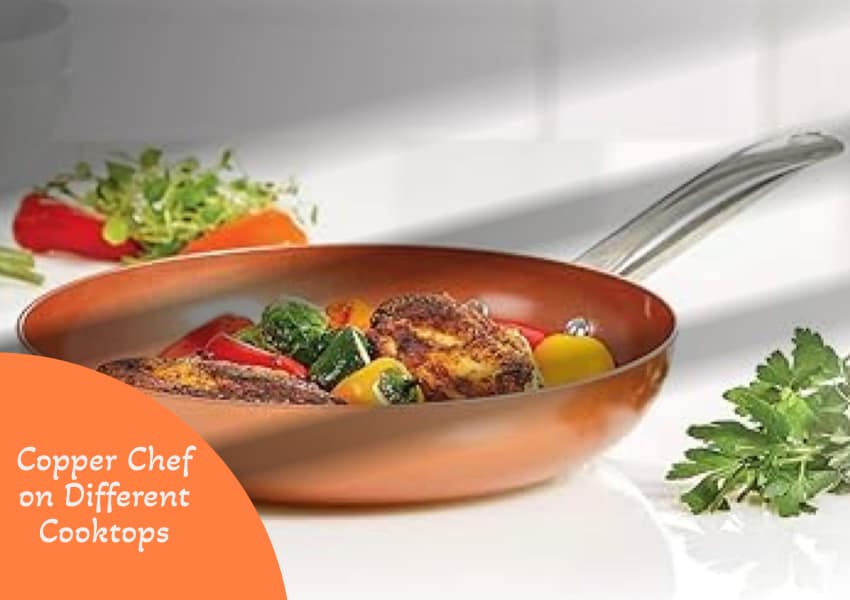
Copper Chef pans are suitable for most stovetops:
Gas – The flat stainless base sits evenly over the flames. Copper quickly adjusts to temperature changes. Use medium to medium-low heat.
Electric Coil – The flat bottom maximizes contact with coils for even heating. Match pan size to coil size.
Glass/Ceramic – The smooth base won’t scratch the cooktop. Prevent overheating on these slow-to-heat surfaces.
Induction – Copper Chef pans work on induction since they have a magnetic stainless-steel base.
Grill – The stainless steel handles high grill heat. Use low direct heat to avoid burning food.
Oven – Safe up to 850°F oven heat. Excellent for roasting and baking casseroles. Avoid broiler.
The versatile design allows Copper Chef to be used on all modern stove types. Follow heat recommendations to optimize performance on each.
Also read: Are Blue Diamond Pans Worth Their Weight in Diamonds?
Copper Chef Usage Tips
Here are some tips for proper use of Copper Chef pans:
1. Before first use:
- Wash with mild soap and water. This removes any residue from manufacturing.
- Season the pan by rubbing a thin coat of oil over the entire inner surface. This primes the nonstick coating.
2. During cooking:
- Use medium-low to medium heat for most cooking. Copper spreads heat fast.
- Let pans preheat before adding food. This prevents sticking or burning.
- Use wood or plastic utensils to avoid scratching the nonstick coating.
3. After cooking:
- Allow pans to cool completely before washing. Thermal shock can damage them.
- Hand wash gently with non-abrasive soap and soft cloth. Avoid abrasive scouring pads.
Following these tips for first-time prep, cooking temperatures, and cleaning will help Copper Chef pans last longer and perform their best.
Seasoning Copper Chef Pans
Seasoning is recommended for new Copper Chef pans:
1. Wash pans first with mild soap and water to remove residue.
2. Rub a thin cooking oil layer over the inner surface. Use oil with a high smoke point.
3. Heat on the stove for 5 minutes to distribute and set the oil.
The seasoning for the nonstick coating for first use helps prevent food from sticking. The oil fills in micro-pores and creates a smooth surface.
Re-seasoning may help revive pans with worn spots:
1. Wash the pan and scrub any damaged areas with baking soda paste.
2. Rinse and dry thoroughly before oiling.
3. Repeat seasoning steps, focusing oil on worn areas.
4. Repeat the process 2-3 times to build up seasoning.
Proper initial seasoning can maximize nonstick life. Re-seasoning may help extend the lifespan of well-used pans.
Also read: Best Granite Stone Pan
Cleaning Copper Chef Pans
Regular proper cleaning preserves Copper Chef pans:
- Let pans cool completely before washing to prevent thermal shock.
- Wash by hand with a non-abrasive sponge or soft cloth. Avoid scouring pads.
- Use mild dish soap, not harsh detergents. Copper Chef says abrasives can damage the nonstick.
- If food sticks, soak in hot water to loosen, then wash gently. Don’t scrub.
- Dry thoroughly with a soft towel to prevent water spots.
- Repeat seasoning with oil after cleaning to maintain the nonstick surface.
- Store carefully to avoid scratches or warping. Use pan protectors if stacking.
Hand washing and gentle cleaning are crucial to maximizing the life of Copper Chef pans. Letting pans cool before washing and re-seasoning also helps.
Copper Chef and Dishwashers
Copper Chef does not recommend their pans for the dishwasher:
- The harsh detergents can damage the nonstick coating over time.
- Aggressive water jets can wear away the seasoning layer.
- High heat drying can degrade the nonstick surface.
- Banging around can dent the pan or chip the coating.
However, occasional dishwashing may be okay if needed:
- Use the lowest heat dry cycle or just air dry.
- Place carefully to avoid banging and scratching.
- Re-season the pan after to maintain a nonstick layer.
It’s best to hand wash Copper Chef pans. But the occasional gentle dishwasher cycle won’t ruin them if followed by re-seasoning. Avoid abrasive cycles.
Maintaining Copper Chef Pans
Some tips for maintaining your Copper Chef pans:
- Season pans before first use and re-season occasionally to upkeep the nonstick.
- Avoid metal utensils that can scratch the coating – use wood, silicone or plastic instead.
- Don’t cut foods directly in the pan. Use a cutting board to avoid slicing the nonstick.
- Clean gently by hand with non-abrasive soap and a soft cloth or sponge.
- Store carefully, and avoid stacking items on top that could dent pans.
- If the nonstick degrades, scrub it with baking soda paste to refresh it.
- · Replace cookware if the coating wears through wholly or the base warps excessively.
With proper seasoning, gentle usage, handwashing, and storage, Copper Chef pans can deliver many years of service. Performing occasional maintenance preserves the nonstick surface.
Copper Chef Warranty Details
Copper Chef provides a limited lifetime warranty on their cookware. Here are essential facts about the warranty:
- It only covers defects in original manufacturing, not normal wear and tear.
- Requires proof of purchase from an authorized retailer for warranty to be valid.
- The customer pays the shipping cost to send pans to Copper Chef for evaluation.
- Copper Chef will repair or replace the pan if a defect is found.
- The warranty does not cover damage from misuse like overheating.
- Warranty only applies to the original purchaser and is not transferable.
- It does not cover the degradation of nonstick coating over time with regular use.
The Copper Chef warranty provides limited protection against manufacturing flaws. But it does not cover damage from normal usage over many years. Review terms carefully before buying.
Copper Chef Pros and Cons
Copper Chef pots and pans have benefits but also some downsides to consider:
- The copper base heats quickly and evenly. This reduces hot spots.
- Ceramic nonstick coating allows low-fat cooking. Easier cleanup.
- Tempered glass lids seal in moisture and flavours.
- Durable stainless-steel sides resist warping. Oven safe.
- The nonstick coating may wear faster than claimed. It requires careful use.
- Handwash recommended. The dishwasher can damage the coating.
- Heavy pans due to copper. They are heavier than aluminium or steel.
- Base requires seasoning and care to maximize nonstick lifespan.
Copper Chef offers fast, even heating, but buyers should weigh its pros and cons versus other cookware. Proper use and care can maximize the benefits.
Ultimately
Copper Chef makes big claims about its cookware. But does it live up to the hype? Here’s how it measures up:
Heating – The copper base heats very fast and evenly. It sears well and avoids hot spots. This matches the ads’ claims.
Nonstick – The ceramic coating is slick initially, but some users report it wears over 6-12 months. Not as durable as claimed.
Cooking – You can cook with less oil than traditional pans. But you’ll still need some oil for most cooking.
Easy Clean – Food doesn’t stick much when new. But once the coating wears, cleanup gets more challenging over time.
Compared to leading brands like All-Clad and Calphalon, Copper Chef offers good but not spectacular performance. The copper base works great. But the nonstick doesn’t last as long as higher-end brands.
For the price, Copper Chef delivers decent quality and cooking ability. But it falls short of being the miraculous cookware portrayed in its marketing. With care, it works well for low-fat cooking and browning. But the nonstick won’t stay perfect forever, as the ads imply.
FAQ
Can Copper Chef pan go in the broiler?
No, Copper Chef does not recommend using their pans under direct broiler heat, which can damage the nonstick coating.
Where are Copper Chef pans made?
Copper Chef cookware is manufactured in China. They are not made in the USA.
How heavy are Copper Chef pans?
Copper Chef pans are heavier than typical aluminium or stainless steel pans due to the copper base. But they are lighter than cast iron or multi-ply stainless pans.
Are replacement Copper Chef lids available?
Yes, Copper Chef sells replacement tempered glass lids on their website, so you can replace the lids if needed.

